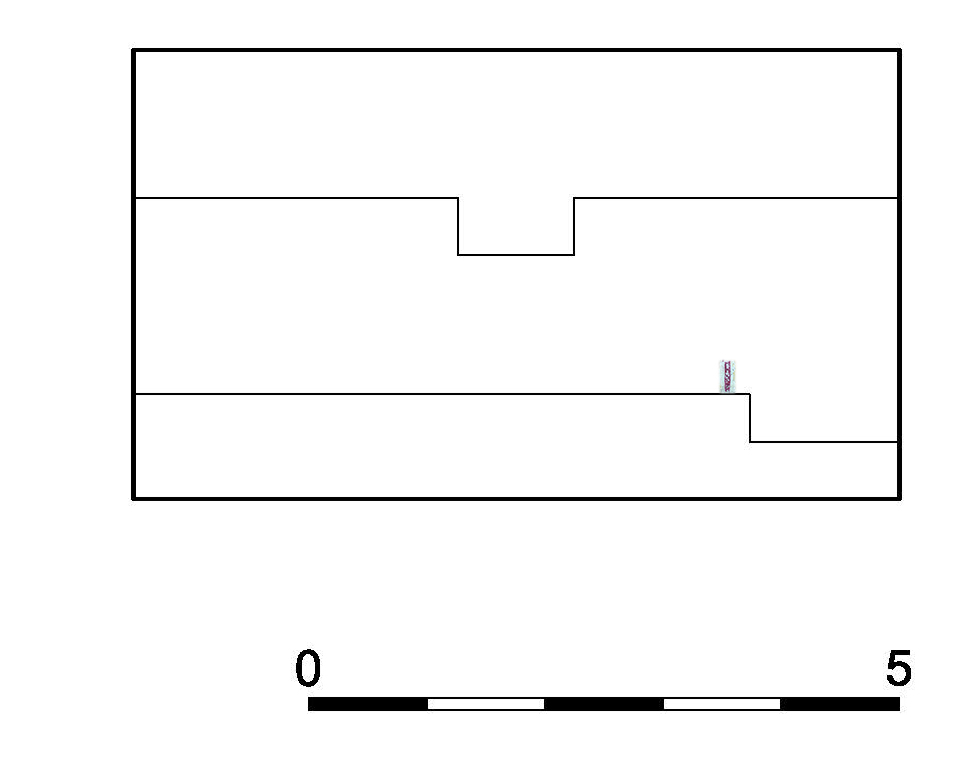



A visible fragment of a red and white bordure of the original late Romanesque or early Gothic mural painting under the Friulian Cycle from around 1400, preserved on the northern wall.[1]
[1] HÖFLER 1997, p. 133. The four layers of mural paintings extend throughout the entire length of the northern nave wall. Three scenes depicted on the same layer of murals follow each other from left to right: St George on horseback fighting a dragon, the Crucifixion, and Mary on the throne with St Barbara and St Dorothea. Judging from the Cosmatesque bordure, which frames the scenes with a pattern of alternating eight-pointed stars and combinations of squares, Janez HÖFLER 1997, p. 133, places this cycle in the opus of the travelling Friulian painters from around 1400. A fragment of one of the intermediate stages of the mural with a crisscross border is located to the right of the scene with Mary on the throne. The Doubting Thomas fresco, dated 1492, is located to its right. Based on its stylistic characteristics, Janez Höfler places it in the opus of the master from the hypothetical Leonard Thanner’s workshop in Udine, known from the upper band depicting saints in Podnanos and Naklo near Škocjan (HÖFLER 1997, pp. 133–134). In addition to the abovementioned murals on the northern wall, the interior side of the former Gothic window in the southern wall features a fragment of a mural depicting a beardless bishop holding a key in his hand. Janez Höfler believes that this mural could possibly represent one of the patron saints of Friuli or Gorizia, perhaps St Hilary or St Tatian and that it shows traits of the soft style of the Carinthian orientation. Thus, it could be conditionally associated with the Master of Srednja vas near Šenčur, who painted in Predjama around 1450. On this basis, he dates the fresco between 1440 and 1450 (HÖFLER 1997, p. 134). The top of the Crucifixion scene was covered by a mural painting of the Crucifixion painted in 1860 by Giovani Serazin and Giovanni Trampus. The fresco is signed and dated. According to an oral source, it was taken down and restored by Mira Ličen Krmpotić.
Pigments: white lime (calcite), red earth (haematite)
Analytical techniques: OM, Raman, XRD
Already to the naked eye, the plaster looks bright. This is confirmed by the cross-sections of the collected samples, where the lime as a binder is dominated by small, bright grains of aggregate, which sometimes also includes much larger, angular, and darker grains (Fig. 1). The XRD analysis of the sample revealed a high calcite content, with the presence of quartz barely detectable. The plaster in question was probably made of lime and crushed limestone with some quartz particles, so it is a high-quality plaster known especially from the Italian Trecento painting as a base for al fresco painting.
Only the white and red colours – the white lime and red earth that the Raman spectroscopy identified as calcite and haematite – have been preserved. The binder is lime from the plaster.
The cross-section of the sample reveals painting on fresh plaster, i.e. al fresco. The potential use of limewash is still being established.
Only a part of the vertical red bordure has been preserved, which is lighter at the edges. It looks like the red colour was applied in two layers, the lower one lighter and the upper one darker, which, however, has not been confirmed by the sample. The bordure was painted with broad brushstrokes. No incisions or underdrawings can be discerned.
Stomaž, Succursal church of St Thomas, Stage 1 (Stomaž), 2024 (last updated 6. 9. 2024). Corpus picturarum muralium medii aevi, https://corpuspicturarum.zrc-sazu.si/en/poslikava/phase-1-stomaz/ (30. 8. 2025).
Legal Terms of Use
© 2025 ZRC SAZU UIFS, Corpus picturarum muralium medii aevi
ZRC SAZU
France Stele Institute of Art History
Novi trg 2
1000 Ljubljana


Spodaj seznam podrobno opisuje piškotke, ki se uporabljajo na našem spletnem mestu.
| Cookie | Type | Duration | Description |
|---|---|---|---|
| _ga | Non-Necessary | 2 years | This cookie is installed by Google Analytics. The cookie is used to calculate visitor, session, camapign data and keep track of site usage for the site's analytics report. The cookies store information anonymously and assigns a randoly generated number to identify unique visitors. |
| _gat | Non-Necessary | 1 minute | Google uses this cookie to distinguish users. |
| _gid | Non-Necessary | 1 day | This cookie is installed by Google Analytics. The cookie is used to store information of how visitors use a website and helps in creating an analytics report of how the wbsite is doing. The data collected including the number visitors, the source where they have come from, and the pages viisted in an anonymous form. |
| cookielawinfo-checkbox-necessary | Necessary | 1 year | This cookie is set by GDPR Cookie Consent plugin. The cookies is used to store the user consent for the cookies in the category "Necessary". |
| cookielawinfo-checkbox-non-necessary | Necessary | 1 year | This cookie is set by GDPR Cookie Consent plugin. The cookies is used to store the user consent for the cookies in the category "Non Necessary". |
| CookieLawInfoConsent | Necessary | 1 year | The cookie is used to store the summary of the consent given for cookie usage. It does not store any personal data. |
| PHPSESSID | session | Time of session | Cookie stores information about the user's session and allow users to keep their entries during the time of visiting the website. |
| pll_language | Necessary | 1 year | This cookie is used to remember any selection a user has made about language. |
| show_preloader_once | Necessary | Session | With this cookie we remember the user's first visit. |
| viewed_cookie_policy | Necessary | 1 year | The cookie is used to store whether or not you have consented to the use of cookies. It does not store any personal data. |